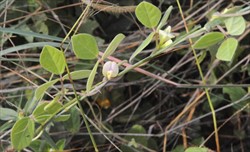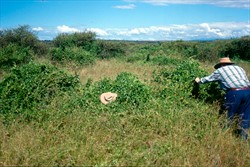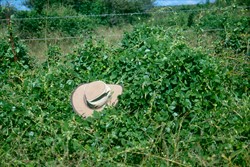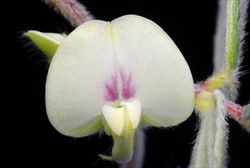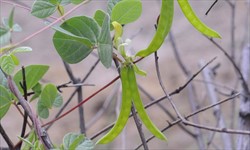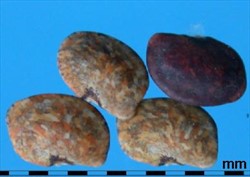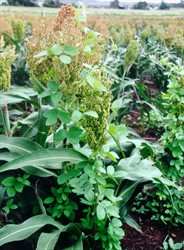Macrotyloma daltonii
Tropical Forages
Macrotyloma daltonii (Webb) Verdc.
Basionym: Dolichos daltonii Webb
Family: Fabaceae (alt. Leguminosae) subfamily: Faboideae tribe: Phaseoleae subtribe: Phaseolinae.
An annual or sometimes perennial climbing or trailing herb to 1.5 m long. Stems slender, covered with long soft hairs. Leaves trifoliolate; leaflets elliptic, 2‒6.8 cm long and 0.7‒4.5 cm wide, acute or acuminate at the apex and cuneate and narrowly to broadly rounded at the base; lateral leaflets sometimes oblique; all leaflets appressed pubescent on both surfaces; dark green above, light below; petioles 1‒6.5 cm long, rachis 4‒10 mm long, petiolules 2‒3 mm long; stipules ovate, lanceolate-triangular, 5‒9 mm long and 2‒3 mm wide and nerved; stipels 2‒3 mm long, narrowly ovate. Flowers axillary, solitary, in pairs or 3‒4-flowered fascicles, pedicels 1.5‒3 mm long, bracts 2 mm long; flowers greenish-yellow to cream or white, sometimes with a mauve mark or veins on the standard; wings and keel narrow, pale greenish-yellow to cream or white. Pods linear to oblong, straight or slightly curved, 2.5–4.5 cm long, 6–8 mm wide and rather laxly covered with long white hairs, 3–6-seeded; beak 3–5 mm long. Seed reddish or pale pinkish-brown and densely mottled with grey and black. Seed size is 4.2–6.0 mm long, 3.5–5.0 mm wide and 1.5–2.0 mm thick. About 50,000 seeds per kg.
None recorded.
Native:
Africa: Angola; Botswana; Democratic Republic of the Congo; Ethiopia; Kenya; Malawi; Namibia; Nigeria; Senegal; South Africa (Limpopo); Sudan; Tanzania; Uganda; Zambia; Zimbabwe
Macaronesia: Cape Verde
Forage
M. daltonii is a productive species that requires further research. It has shown promise in early evaluation as a self -regenerating annual in permanent and ley pastures.
Environment
Its vigorous growth suggests it might also have application as a green manure.
Soil requirements
Occurs in grassland, wooded grassland, woodland, bushland and thicket, mostly on deep sands, loams and sandy loams, but also on stony soils and clays, with pH of 6–8.
Moisture
Rainfall at collection sites ranges from 350–775 mm/yr (mostly 600–700 mm).
Temperature
Extends from about 16º N in Cape Verde, 12º N in Sudan to about 23º S (900 m asl) in South Africa, and at 1,650 m asl at 4.7º S in Tanzania.
Light
Low shade tolerance.
Reproductive development
Short day plant. Flowering characteristics vary with ecotype. Few seeds by end of March at 19º S. Seed collected early to mid April at 20º S. Pods nearly 100% shattered by mid-June at 6º S.
Defoliation
High growing points (>7 cm) on the basal stem make it intolerant of regular defoliation.
Fire
No information available.
Guidelines for establishment and management of sown forages.
Establishment
Easily established in cultivated seedbeds with surface and near surface sowing. Large seed size and fast germination rate enhance the success of establishment. Can also re-establish very successfully from soil seed in crop situations and also in permanent pastures but regeneration is erratic in competition with strong growing grasses.
Fertilizer
Although growing fairly well at low fertility, even on old cultivation land, it responds to applications of 10–20 kg/ha P on these poorer soils.
Compatibility (with other species)
Grows successfully with tufted grasses and other twining and shrub legumes. The twining habit enables M. daltonii to climb taller grasses and crop plants, and to smother weeds.
Companion species
Grasses: Heteropogon contortus, Megathyrsus maximus, Urochloa mosambicensis, U. oligotricha.
Legumes: Macroptilium atropurpureum, Macrotyloma axillare, Neonotonia wightii, Stylosanthes scabra.
Pests and diseases
Root disease can cause wilting and death in wet conditions on clay soils.
Ability to spread
Limited ability to spread. High seed production but has to regenerate each year and does not compete with strong growing perennial grasses.
Weed potential
Low potential in grasslands but could be weed of summer cropping areas.
Nutritive value
Leaves have high nutritive value and low acid detergent fibre (ADF) but N content in comparison with Lablab and Macroptilium is lower. Stems are lower in N and higher in ADF than Lablab and Macroptilium.
Palatability/acceptability
Less readily eaten by grazing beef cattle than Vigna trilobata, Macroptilium bracteatum, Lablab purpureus and Clitoria ternatea in grazing trials. In grasslands, M. daltonii is grazed most readily late in summer.
Toxicity
None reported.
Dry matter
Depending on rainfall and the length of the growing season, yields of pure swards can range from 1 to 4 t/ha. In grasslands, yields are lower and highly variable.
Animal production
On grasslands with M daltonii as a legume component, animal growth rates can be improved over grass-only pastures by up to 60 kg/head/year. However, when grazed as a legume forage crop, animal growth rates of steers were lower (0.35–0.66 kg/head/day) than for those grazing lablab (Lablab purpureus) (0.6–0.86 kg/head/day) and cowpea (Vigna unguiculata) (0.55–0.79 kg/head/day), possibly because of reduced intakes of the less palatable M daltonii.
Little or no breeding or selection work has been done with M. daltonii.
Seed production can be high but recovery is likely to be difficult because of seed shattering. Suction harvesting as for other Macrotyloma spp. could be the most efficient seed harvesting strategy.
Susceptible to a range of broad-leaf herbicides including dicamba, MCPA, metsulfuron-methyl and fluroxypyr.
- Easy establishment.
- High seed production.
- Ability to regenerate from soil seed annually.
- Lower palatability than other legumes.
- Not tolerant of cutting.
Blumenthal, M.J. and Staples, I.B. (1993) Origin, evaluation and use of Macrotyloma as forage -a review. Tropical Grasslands 27:16–29. bit.ly/3awFf8j
Blumenthal, M.J., O'Rourke, P.K., Hilder, T.B. and Williams, R.J. (1989) Classification of the Australian collection of the legume Macrotyloma. Australian Journal of Agricultural Research 40(3):591–604. doi.org/10.1071/AR9890591
Clem, R.L. (2004) Animal production from legume-based pastures in Southeastern Queensland. In: Whitbread, A.M. and Pengelly, B.C. (eds) Tropical legumes for sustainable farming systems in southern Africa and Australia. ACIAR Proceedings No. 115. Australian Centre for International Agricultural Research (ACIAR), Canberra, Australia. p. 136–144. aciar.gov.au/node/8436
Dalzell, S.A., Brandon, N.J. and Jones, R.M (1997) Response of Lablab purpureus cv. Highworth, Macroptilium bracteatum and Macrotyloma daltonii to different intensities and frequencies of cutting. Tropical Grasslands 31:107–113. bit.ly/2UvTDYA
Gillett, J.B., Polhill, R.M. and Verdcourt, B. (1971) Leguminosae (Part 3) Subfamily Papilionoideae. In: Milne-Redhead, E. and Polhill, R.M. (eds) Flora of Tropical East Africa. Crown Agents for Overseas Governments and Administrations, London, UK. p. 313–314.
Verdcourt, B. (1970) Studies in the Leguminosae-Papilionoideae for the 'Flora of Tropical East Africa': III. Kew Bulletin 24:402. doi.org/10.2307/4102845
Verdcourt, B. (1980) The classification of Dolichos L. emend. Verdc., Lablab Adans., Phaseolus L., Vigna Savi and their allies. In: Summerfield, R.J. and Bunting, A.H. (eds) Advances in Legume Science. Kew Royal Botanic Gardens, Kew, UK. p. 45–48.
Verdcourt, B. (1982) A revision of Macrotyloma (Leguminosae). Hooker's Icones Plantarum 38(4):1–138.
Whitbread, A.M. and Clem, R.L. (2006) Graze to grain—measuring and modelling the effects of grazed pasture leys on soil nitrogen and sorghum yield on a Vertosol soil in the Australian subtropics. Australian Journal of Agricultural Research 57(5):489–500. doi.org/10.1071/AR05189
None released to date.
CPI 60303 Selected in Queensland, Australia. Origin Huila Plateau, Namibia (20.5º S, 16.12º E, 1,270 m asl, rainfall 350 mm). A vigorous, leafy, early flowering accession.
